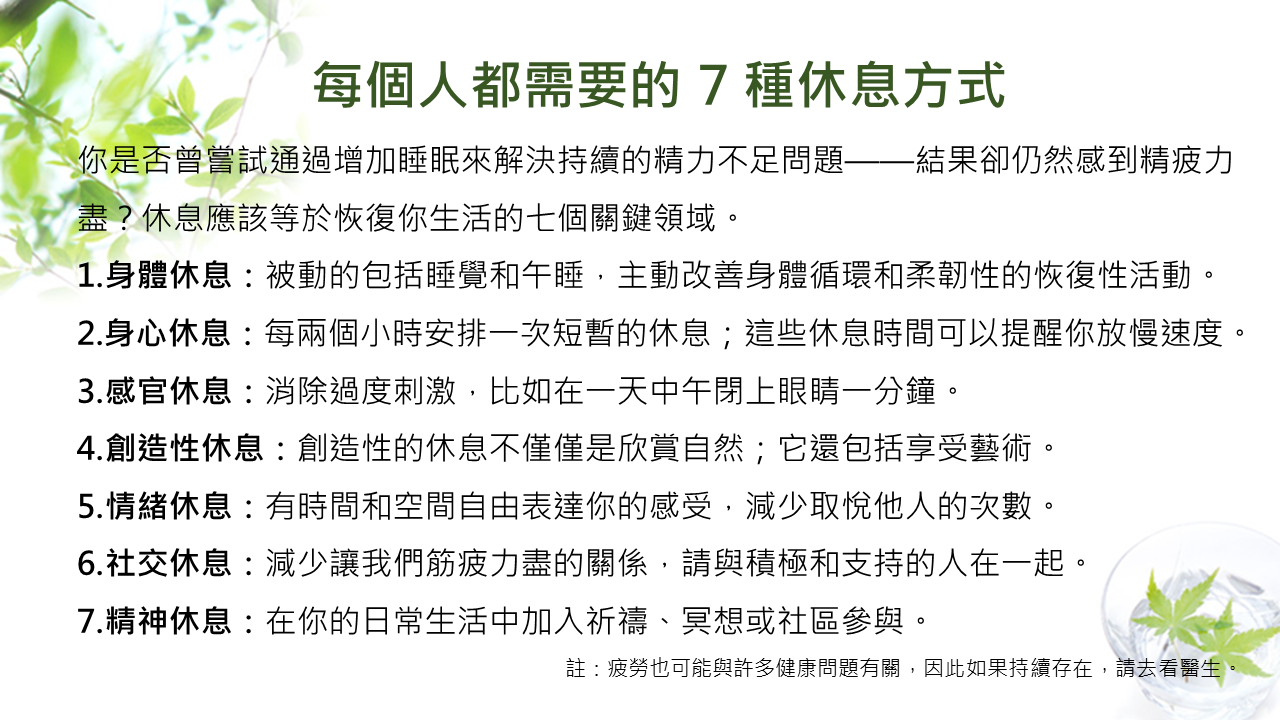The 7 types of rest that every person needs
Have you ever tried to fix an ongoing lack of energy by getting more sleep — only to do so and still feel exhausted?
If that’s you, here’s the secret: Sleep and rest are not the same thing, although many of us incorrectly confuse the two.
We go through life thinking we’ve rested because we have gotten enough sleep — but in reality we are missing out on the other types of rest we desperately need. The result is a culture of high-achieving, high-producing, chronically tired and chronically burned-out individuals. We’re suffering from a rest deficit because we don’t understand the true power of rest.
Rest should equal restoration in seven key areas of your life.
The first type of rest we need is physical rest, which can be passive or active. Passive physical rest includes sleeping and napping, while active physical rest means restorative activities such as yoga, stretching and massage therapy that help improve the body’s circulation and flexibility.
The second type of rest is mental rest. Do you know that coworker who starts work every day with a huge cup of coffee? He’s often irritable and forgetful, and he has a difficult time concentrating on his work. When he lies down at night to sleep, he frequently struggles to turn off his brain as conversations from the day fill his thoughts. And despite sleeping seven to eight hours, he wakes up feeling as if he never went to bed. He has a mental rest deficit.
The good news is you don’t have to quit your job or go on vacation to fix this. Schedule short breaks to occur every two hours throughout your workday; these breaks can remind you to slow down. You might also keep a notepad by the bed to jot down any nagging thoughts that would keep you awake.
The third type of rest we need is sensory rest. Bright lights, computer screens, background noise and multiple conversations — whether they’re in an office or on Zoom calls — can cause our senses to feel overwhelmed. This can be countered by doing something as simple as closing your eyes for a minute in the middle of the day, as well as by intentionally unplugging from electronics at the end of every day. Intentional moments of sensory deprivation can begin to undo the damage inflicted by the over-stimulating world.
The fourth type of rest is creative rest. This type of rest is especially important for anyone who must solve problems or brainstorm new ideas. Creative rest reawakens the awe and wonder inside each of us. Do you recall the first time you saw the Grand Canyon, the ocean or a waterfall? Allowing yourself to take in the beauty of the outdoors — even if it’s at a local park or in your backyard — provides you with creative rest.
But creative rest isn’t simply about appreciating nature; it also includes enjoying the arts. Turn your workspace into a place of inspiration by displaying images of places you love and works of art that speak to you. You can’t spend 40 hours a week staring at blank or jumbled surroundings and expect to feel passionate about anything, much less come up with innovative ideas.
Now let’s take a look at another individual — the friend whom everyone thinks is the nicest person they’ve ever met. It’s the person everyone depends on, the one you’d call if you needed a favor because even if they don’t want to do it, you know they’ll give you a reluctant “yes” rather than a truthful “no”. But when this person is alone, they feel unappreciated and like others are taking advantage of them.
This person requires emotional rest, which means having the time and space to freely express your feelings and cut back on people pleasing. Emotional rest also requires the courage to be authentic. An emotionally rested person can answer the question “How are you today?” with a truthful “I’m not okay” — and then go on to share some hard things that otherwise go unsaid.
If you’re in need of emotional rest, you probably have a social rest deficit too. This occurs when we fail to differentiate between those relationships that revive us from those relationships that exhaust us. To experience more social rest, surround yourself with positive and supportive people. Even if your interactions have to occur virtually, you can choose to engage more fully in them by turning on your camera and focusing on who you’re speaking to.
The final type of rest is spiritual rest, which is the ability to connect beyond the physical and mental and feel a deep sense of belonging, love, acceptance and purpose. To receive this, engage in something greater than yourself and add prayer, meditation or community involvement to your daily routine.
As you can see, sleep alone can’t restore us to the point we feel rested. So it’s time for us to begin focusing on getting the right type of rest we need.
Editor’s note: Fatigue can also be associated with numerous health problems, so please get checked out by your physician if it persists.
To learn more about Dr. Saundra Dalton-Smith and her work, visit her website. This post was adapted from her TEDxAtlanta Talk. Watch it here:

![]()
每個人都需要的 7 種休息方式
你是否曾嘗試通過增加睡眠來解決持續的精力不足問題——結果卻仍然感到精疲力盡?
休息應該等於恢復你生活的七個關鍵領域。
- 身體休息:被動的身體休息包括睡覺和午睡,而主動的身體休息是指有助於改善身體循環和柔韌性的恢復性活動,例如瑜伽、伸展運動和按摩療法。
- 身心休息:在整個工作日中每兩個小時安排一次短暫的休息;這些休息時間可以提醒你放慢速度。你也可以在床邊放一個記事本,記下任何讓你睡不著覺的想法。
- 感官休息:消除過度刺激(明亮的燈光、電腦螢幕、背景噪音和多次談話),比如在一天中午閉上眼睛一分鐘。
- 創造性休息:有創意的休息會重新喚醒我們每個人內心的敬畏和驚奇。你還記得你第一次看到大峽谷、海洋或瀑布的情景嗎?讓自己欣賞戶外的美景(即使是在當地的公園或自家後院)也能為你提供創造性的休息。但創造性的休息不僅僅是欣賞自然;它還包括享受藝術。
- 情緒休息:有時間和空間自由表達你的感受,減少取悅他人的次數。
- 社交休息:區分那些讓我們恢復活力的關係和那些讓我們筋疲力盡的關係,請與積極和支持的人在一起。即使你的互動必須以虛擬方式進行,你也可以選擇通過打開視訊並專注於與你交談的人來更充分地參與其中。
- 精神休息:這是一種超越身體和精神聯繫的能力,能夠感受到一種深刻的歸屬感、愛、接納和目的感。請從事比你自己更偉大的事情,並在你的日常生活中加入祈禱、冥想或社區參與。
註:疲勞也可能與許多健康問題有關,因此如果持續存在,請去看醫生。
-
Souce: The 7 types of rest that every person needs,
https://ideas.ted.com/the-7-types-of-rest-that-every-person-needs/
